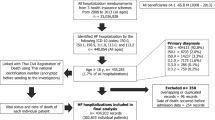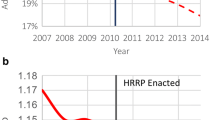Abstract
Heart failure (HF) is one of the leading causes of hospitalization and readmissions. Our study aimed to examine racial disparities in heart failure patients including onset, mortality, length of stay (LOS), direct costs, and readmission rates. This is a secondary data analysis. We analyzed the risk-adjusted inpatient data of all patients admitted with HF to one health academic center. We compared five health outcomes among three racial groups (white, black, and Hispanic). There were 1006 adult patients making 1605 visits from 10/01/2011 to 09/30/2015. Most black patients were admitted in younger age than other racial groups which indicates the needs for more public health preventions. With risk adjustments, the racial differences in LOS and readmission rates remain. We stratified health outcomes by race/ethnic and type of HF. The findings suggest that further studies to uncover underlying causes of these disparities are necessary. Using risk-adjusted hospitalization data allows for comparisons of quality of care across three racial groups. The study suggests that more prevention and protection services are needed for African American patients with heart failure.

Similar content being viewed by others
References
Roger V. Epidemiology of heart failure. Circ Res. 2013;113:646–59.
Centers for Disease Control and Prevention (CDC). Heart failure fact sheet. http://www.cdc.gov/dhdsp/data_statistics/fact_sheets/fs_heart_failure.htm.
American Heart Association. Heart disease and stroke statisticis-2016 update. https://circ.ahajournals.org/content/early/2015/12/16/CIR.0000000000000350.
Ni H, Xu JQ. Recent trends in heart failure-related mortality: United States, 2000–2014. NCHS data brief, no 231. Hyattsville, MD: National Center for Health Statistics. http://www.cdc.gov/nchs/data/databriefs/db231.htm.
Sharma A, Colvin-Adams M, Yancy CW. Heart failure in African Americans: disparities can be overcome. Clevel Clin J Med. 2014;81(5):301–11.
National Heart, Lung, and Blood Institute. What is heart failure? https://www.nhlbi.nih.gov/health/health-topics/topics/hf.
Center of Continuous Education at Cleveland Clinic. Diseases management: heart failure. 2017. http://www.clevelandclinicmeded.com/medicalpubs/diseasemanagement/cardiology/heart-failure/.
American Heart Association. Types of Heart Failure. 2017. http://www.heart.org/HEARTORG/Conditions/HeartFailure/AboutHeartFailure/Types-of-Heart-Failure_UCM_306323_Article.jsp#.WiBcHDdryVA.
Medical Clinics. Pathophysiology of systolic and diastolic heart failure. 2017. http://www.medical.theclinics.com/article/S0025-7125(12)00123-X/abstract.
Ashley EA, Niebauer J. Chapter 7: Heart failure. In: Cardiology explained. London, UK: Remedica. http://www.ncbi.nlm.nih.gov/books/NBK2218/.
Borlaug BA, Redfield MM. Are systolic and diastolic heart failure overlapping or distinct phenotypes within the heart failure spectrum? Circulation. 2011;123:2006–14.
Davis A, et al. Cardiovascular health disparities. Med Care Res Rev. 2007;64(5 Suppl):29S–100S.
Graham G. Population-based approaches to understanding disparities in cardiovascular disease risk in the United States. Int J Gen Med. 2014;7:393–400.
Center to Eliminate Health Disparities (CEHD). Disparity documentation report and improvement plans. Galveston, TX: University of Texas Medical Branch. http://www.utmb.edu/hpla/health-disparities/publications.
University of Utah. What is the University HealthSystem Consortium? Health care: a community to quality. http://healthcare.utah.edu/quality/consortium.php.
ICD9Data.com Heart Failure 428. http://www.icd9data.com/2014/Volume1/390-459/420-429/428/default.htm.
University HealthSystem Consortium. UHC risk adjustment methodology. Chicago, IL: UHC; 2014.
University HealthSystem Consortium. UHC clinical data base/resource manager user manual. Chicago, IL: UHC; 2015.
StataCorp LP. Generalized estimating equations: xtgee. http://www.stata.com/features/generalized-estimating-equations/.
Escarce JJ, Kapur K. Chapter 10: access to and quality of health care. In: Tienda M, Mitchell F, editors. Hispanics and the future of America. Washington DC: National Academies Press; 2006.
Bui AL, Horwich TB, Fonarow GC. Epidemiology and risk profile of heart failure. Nat Rev Cardiol. 2011;8(1):30–41.
Lan T, et al. Social determinants of cardiovascular diseases. Public Health Rev. 2012;33(2):601 – 22.
Melton KD, et al. Heart failure in Hispanic Americans: improving culture awareness. School of Nursing Faculty Publications of Purdue University. http://docs.lib.purdue.edu/cgi/viewcontent.cgi?article=1026&context=nursingpubs.
Calvillo-King L, et al. Impact of social factors on risk of readmission or mortality in pneumonia and heart failure: systematic review. J Gen Intern Med. 2012;28(2):269–82.
Rahimi K, et al. Risk prediction in patients with heart failure. JCHF. 2014;2(5):440–6.
Ross JS, et al. Statistical models and patient predictors of readmission for heart failure: a systematic review. Arch Intern Med. 2008;168(13):1371–86.
Yang H, et al. Clinical prediction of incident heart failure risk: a systematic review and meta-analysis. Open Heart. 2015;2(1):e000222.
Gardetto NJ. Self-management in heart failure: where have we been and where should we go? J Multidiscip Healthc. 2011;4:39–51.
Hubbard T, McNeill N. Improving medication adherence and reducing readmissions. http://www.nacds.org/pdfs/pr/2012/nehi-readmissions.pdf.
Damiani G, et al. Influence of socioeconomic factors on hospital readmissions for heart failure and acute myocardial infarction in patients 65 years and older: evidence from a systematic review. Clin Interv Aging. 2015;10:237–45.
Giamouzis G, et al. Hospitalization epidemic in patients with heart failure: risk factors, risk prediction, knowledge gaps, and future directions. J Card Fail. 2011;17(1):54–75.
Tschihashi M, et al. Medical and socioenvironmental predictors of hospital readmission in patients with congestive heart failure. Am Heart J. 2001;142(4):E7.
Desai AS, Stevenson LW. Re-hospitalization for heart failure: predict or prevent? Circulation (Special Report). 2012;126:501–6.
Voigt J, et al. A reevaluation of the costs of heart failure and its implications for allocation of health resources in the United States. Clin Cardiol. 2014;37(5):312–21.
Joint Commission. Specification manual for Joint Commission National Quality Core Measures. https://manual.jointcommission.org/releases/archive/TJC2010B/HeartFailure.html.
Ranasinghe I, et al. Readmissions after hospitalization for heart failure, acute myocardial infarction, or pneumonia among young and middle-aged adults: a retrospective observational cohort study. PLOS Med. 2014;11(9):e1001737.
Yancy C, Strong M. The national history, epidemiology, and prognosis of heart failure in African Americans. http://www.medscape.com/viewarticle/468119.
Centers for Medicare and Medicaid Services (CMS). Innovation models. https://innovation.cms.gov/initiatives/index.html#views=models.
Acknowledgements
The researchers would like to express the deepest gratitude to the following departments that without their help, this project would not be possible: (1) University of Texas Medical Brach Office of the President-Waiver Operations, (2) Clinical Data Management, and (3) Office of Health Policy and Legislative Affairs.
Funding
The study received financial funding from Texas Medicaid 1115 Waiver (#094092602.1.9).
Author information
Authors and Affiliations
Corresponding author
Ethics declarations
Conflict of interest
No conflict of interest or others exists.
Ethical Approval
The study has acquired the approval of Institutional Review Board (#16-0128) at University of Texas Medical Branch and has complied with all requirements for a secondary data analysis to protect privacy of health information.
Rights and permissions
About this article
Cite this article
Lee, WC., Serag, H., Ohsfeldt, R.L. et al. Racial Disparities in Type of Heart Failure and Hospitalization. J Immigrant Minority Health 21, 98–104 (2019). https://doi.org/10.1007/s10903-018-0727-4
Published:
Issue Date:
DOI: https://doi.org/10.1007/s10903-018-0727-4




